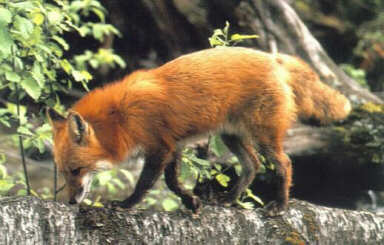
Though the red fox is primarily a solitary animal, it nevertheless has a complicated social life that is not yet fully understood. Much of a fox´s social life occurs when it is growing up, mating, or raising it´s young, however social interaction also plays a role when a fox is staking out or defending it´s home territory.
A fox´s home range typically varies between 60 and 160 hectares.. The primary factors affecting size are the amount of food supply, population density, and the type of habitat in question (urban ranges can be as small as 10 ha while desert territories exceeding 5000 ha are not unknown). One of the chief means of fox communication is through the scent marking of these ranges.
 |
| Scent plays a major role, both in locating food and in social interactions between foxes. |
In scent marking, the fox patrols the boundary areas of its territory and leaves various markers that serve notice of its presence to other foxes. Feces are usually deposited in highly visible places and urine is then sprayed around the area. The droppings may also be sprayed with a bacteria rich fluid from the animals anal sacs (researchers don´t yet know why the animal does this, why it sometimes does not, or why males a prone to do so more than females.) In addition to leaving droppings, a fox frequently urinates on prominent land marks such as stumps, fence posts, and rocks to further announce its presence. These marks are normally "refreshed" every few days.
Marking behaviour varies among foxes based on environmental conditions, location within the range, and the personality of the individual animal. A fox is less likely to mark areas in its range that are unproductive hunting grounds and will tolerate the intrusion of others in these places to some extent. On the other hand, highly productive hunting grounds may be heavily marked and defended. In an area where fox population is sparse and food is abundant, some animals tend not to leave marks for most of the year. Nevertheless, all foxes will scent mark during the breeding season, and their presence can be determined by the strong, skunky smell their urine takes on at these times.
Scent marking helps a fox keep track of where it has been and lets it tell others of its sex, status, and individual identity. It also reduces the need for conflict among foxes. Territorial boundaries are generally respected except during food shortages, when mates are scarce, or when young males are dispersing from their parent´s ranges. When a fox does find its territory has been invaded, the results may vary. Members of the opposite sex tend to be more tolerant of one another, and disputes between neighbours are usually ritualized contests, without any real attempt to hurt one another. However, when a stranger of the same sex is encountered, fighting can be quite uninhibited. Young males leaving home for the first time frequently encounter frightening confrontations when they stumble onto an angry fox´s home territory.
| Table of Contents |